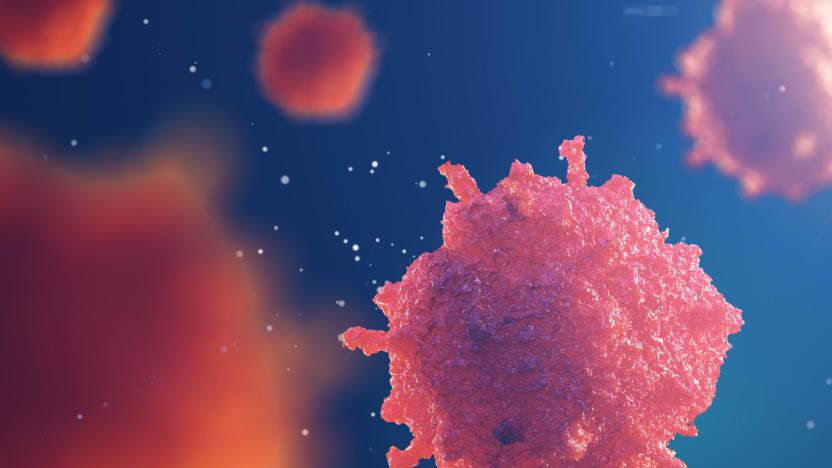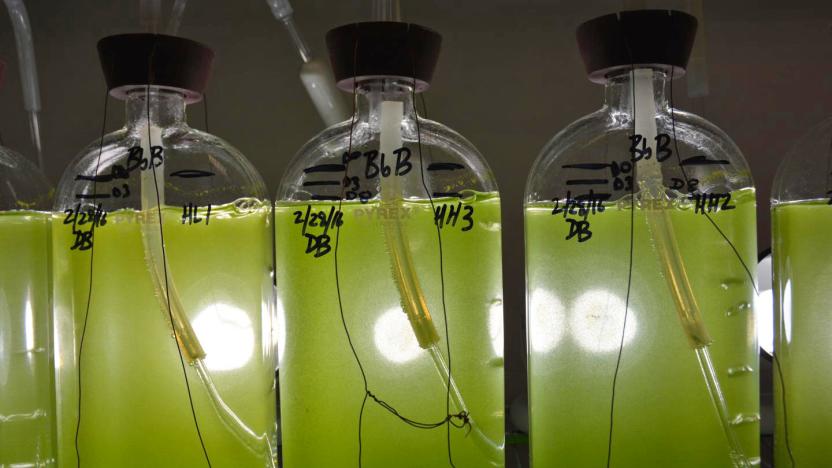algae
Latest

Get ready to eat bugs if you want to live beyond 2050
By 2050 there will be an estimated 10 billion humans living on this planet. Beyond that being a lot of mouths to feed, those folks will be, on average, wealthier than today's population, with a taste for the foods found in regions like the US and Western Europe. But we simply don't have the capability, the land or the production resources to ensure that many people can eat a cheeseburger whenever the mood strikes. Luckily, researchers from around the globe are working on alternative-protein sources to supplement our existing beef, pork and chicken.
Andrew Tarantola01.28.2020
Kanye West's sustainable Yeezy concept uses algae foam
The next sneaker in Kanye West's Yeezy line could be made from algae foam. West offered a glimpse of the shoe at Fast Company's Innovation Festival today. He also shared that Yeezy is planning to move its headquarters to a 4,000-acre ranch in Wyoming, where it will grow its own algae in a hydroponic farm.
Christine Fisher11.07.2019
Algae-based nanobots could diagnose you from the inside
Nanobots promise a breakthrough in medicine by letting doctors study and treat you without invasive surgery or relatively ineffective drugs. But they face a couple of key problems: it's not easy to steer them to where they're needed, and getting rid of them is difficult when they're finished. Researchers might have a solution: make them out of natural materials that are guaranteed to break down. They've crafted nanobots (not pictured) using the sort of spirulina algae you can find in health food stores. The natural composition not only lets them biodegrade gracefully, but makes them relatively easy to control and track.
Jon Fingas11.22.2017
Sea lions are getting sick from toxic algae blooms
Sea lions off of the coast of California are getting very sick and it's because of increased blooms of toxic algae. The algae release a chemical called domoic acid and when sea lions eat fish that feed on the algae, it causes seizures, gastrointestinal issues and can lead to brain damage. For many sea lions, the poisoning is a death sentence. "It's hard. It's really hard to watch these animals suffer, especially if there's not something we can do to stop these blooms from happening," Cara Field a veterinarian with the Marine Mammal Center told CBS News.
Mallory Locklear08.14.2017
After Math: Baby come back
This was a week of many happy returns. Stanford students brought back 5,000 year old Chinese beer, Prince's catalog has reappeared on streaming services not owned by Jay Z and a pair of classic Hot Wheels cars are coming out of retirement to make their Rocket League debut. Numbers, because how else will we know how long you've been gone?
Andrew Tarantola02.12.2017
Algae can survive nearly a year and a half in outer space
Algae from the Arctic Circle are used to tough weather, and it turns out they're also able to survive the extreme conditions of outer space. Two specimens recently spent 16 months on the exterior of the International Space Station and became the first plants to make it through these conditions. The algae, of the Sphaerocystis species, returned to Earth last June after 530 days on a panel outside the ISS, the Fraunhofer research organization announced last week. The specimens withstood conditions including intense ultraviolet radiation, temperatures ranging from -20°C to 47.2°C, and, of course, the vacuum of space.
Derrick Rossignol02.09.2017
Soylent partner cuts supply after shouldering blame for recall
Soylent supplier TerraVia really, really doesn't appreciate being blamed for making people sick. The nutrition company has suspended its ingredient supply out of a "high level of concern" that Soylent is perpetuating a "pattern of behavior" that hurts TerraVia's bottom line. Supposedly, Soylent didn't do enough research into gastrointestinal problems before blaming TerraVia's algal flour and removing it for the recently released Powder 1.7 meal. The food alternative firm didn't offer any evidence, TerraVia says, citing an industry expert who doubts that the flour (or any one ingredient) is the obvious cause.
Jon Fingas12.20.2016
Six green designs powered by algae
By Cat DiStasio It's easy to underestimate the awesome superpowers of the tiny plants we all know as algae. The photosynthetic organisms are minuscule powerhouses capable of generating light and energy while scrubbing greenhouse gas emissions from the air. Many types of algae are also edible, fueling the human body with hard-to-get vitamins and minerals. Over the years, designers and engineers have worked to incorporate algae into everything from energy-generating furniture to air-cleaning light fixtures and even pollution-busting highway overpasses, all in an attempt to put the tiny plants to work for people in very real ways. The trend of integrating algae into product design continues, growing more efficient and fantastic with each passing year. Here are some of the most exciting ways that algae is changing the future of design.
Inhabitat11.12.2016
Algae's enzyme might hold the secret to mass producing biofuel
A common microscopic pond and lake alga named Botryococcus braunii makes big amounts of liquid hydrocarbons that can be used to make biofuel. Problem is, we can't use the organism itself as a source, because it grows very slowly. A group of scientists from Texas A&M AgriLife Research, however, is looking into what genes are responsible for producing its enzyme that initiates the production of oil. See, the group wants to replicate its ability to make big amounts of oil in other plants more suitable for mass production. And they think the key is to express the enzyme's associated genes in those other organisms, such as faster-growing algae.
Mariella Moon04.07.2016
Algae DNA could help the blind see in upcoming trials
Optogenetics is one of the greatest achievements in gene splicing over the last decade, as it has helped researchers see how the brain works in animals by making neurons react to light. For the first time, however, the technique will be tried on a human subjects to help legally blind folks see for the first time. Using research developed by Wayne State University scientist Zhuo-Hua Pan, a company called RestroSense will inject a virus doped with light-sensitive algae DNA directly into a patient's eyes. So far, the only successful attempts at restoring vision in humans has come using the Argus II implant.
Steve Dent02.22.2016
Algae-based thread will keep your clothes odor-free
If you're worried that the silver ions in antibacterial and anti-odor clothing might also pose serious health risks, like destroying genetic material, you'll be glad to hear that there should soon be a safer alternative. The KTH Royal Institute of Technology has developed an antibacterial thread that uses a mix of bio-compatible plastics and lanosol, a bacteria-fighting compound that you normally find in red algae. The material should not only be a less contentious germ-killer than silver, but more effective. Because it's woven into super-thin fibers through electrospinning (which uses electrical charges to draw thread from liquid), the antiseptic element doesn't clump up and leave some areas unprotected.
Jon Fingas10.01.2014
Dino Pet: marine algae in a sauropod-shaped case that glow when irritated
Build a better Sea Monkey and the world will -- well, fund your Kickstarter campaign, hopefully. Dino Pet's certainly got a couple of things going for it: tiny glowing animals and dinosaurs. The pet's creators clearly took the whole "dino" part of dinoflagellates to its logical extreme, fashioning a sauropod-esque transparent casing for the bioluminescent marine algae. Caring for the tiny glowing creatures is fairly easy: expose them to sun during the day and give 'em a shake at night and agitate them into glowing for you. The Dino's creators also provide food, to help keep 'em going. A $40 pledge will get you one (the $30 level is, sadly, all sold out now) when they start shipping in February. More information can be had in the source link below, including whether or not you should drink them once they arrive.
Brian Heater08.21.2013
Shell Oil pulls the plug on its last algae biodiesel research project
Algae biodiesel has looked so promising (as in 100 times more fuel than corn or soy) that the U.S. Department of Energy gave $9 million to Cellana, a joint research venture between Shell Oil and HR Biopetroleum, specifically to look into the alternative energy source's prospects. It seems, however, that those prospects were no longer attractive to Shell, which has announced it will no longer pursue algae biodiesel, because it feels it doesn't have sufficient commercial viability. Partner HR Biopetroleum has stated it cannot continue the project on its own as Shell pursues other biofuel initiatives with other companies.
Laura June Dziuban02.03.2011
Stanford researchers harvest electricity from algae, unkempt pools become gold mines
While we've seen plenty of stabs at viable green energy, from underwater turbines to the Bloom Box, we're always up for another. Running along the same lines as Uppsala University's algae-based batteries, researchers at Stanford are generating electrical current by tapping into the electron activity of individual algae cells. The team designed a gold electrode that can be pushed through a cell membrane, which then seals around it. The cell, still alive, does what it does best (photosynthesis), at which point scientists harvest chemical energy in the form of electrons. According to Stanford University News, this results in "electricity production that doesn't release carbon into the atmosphere. The only byproducts of photosynthesis are protons and oxygen." Of course, the team has a long way to go before this is economically feasible, but who knows? Maybe there's an algae-powered OPhone in your future...
Joseph L. Flatley04.15.2010
Ultrathin, algae-based batteries could charge things you never thought possible
Somehow or another, we've figured out how to send mere mortals to the moon, create (and mass produce) a laptop thin enough to floss with and add multitouch capabilities to a mouse. But for whatever reason, we're still stuck using AA batteries that last approximately one-fifth as long as you need them to. Outside of a few breakthroughs here and there, the battery industry at large has found a holding pattern that digs at consumers and likely fattens the wallets of those in charge. Thanks to new research surrounding the use of Cladophora (green algae) in a flexible, ultrathin alternative, it looks as if we may finally be onto something good. Researchers purport that these super skinny cells could be placed in areas where batteries are currently unable to go -- think of perpetually charged wall sensors, energized clothing or even light-up wrapping paper. Better still, prototypes have shown the ability to hold a significant charge, but unfortunately for us all, no specific production date has been pegged. A boy can dream though, yeah?
Darren Murph11.29.2009
GreenFuel Technologies signs deal to build algae fuel plant
As we've seen already, algae is big business these days, and it now looks like the alternative source of fuel is getting another shot in the arm, with GreenFuel Technologies recently announcing a deal to build an "algae-to-fuel" plant in Europe. The company, as you may or may not know, is now headed (at least temporarily) by Ethernet pioneer Bob Metcalf, with its main claim to fame being a bioreactor that's designed to grow algae from the carbon dioxide emissions of power plants. While complete details are still pretty light at the moment, that bit of technology was apparently enough to score it a $92 million deal with somebody (actually negotiated by the former CEO), which is reportedly contingent on it first building a small scale pilot plant and meeting cost and productivity goals along the way. As Xconomy reports, however, this latest development follows some hard times faced by the company, during which time it actually had to shut down one of its algae greenhouses after it produced more algae than the system could handle.[Via Green Tech Blog]
Donald Melanson03.17.2008
Upstart Solazyme promises to make fuel from algae
It's not the first to turn to algae and biomass as a source of fuel, but upstart Solazyme seems to think it's got a leg up on other biofuel makers and its apparently lining up the deals and big bucks to prove it. As Technology Review reports, that includes Chevron, which is now in a "testing agreement" with the start-up, and the National Institute of Standards and Technology, which dished out a $2 million grant to the company. The trick that's attracted all that interest, it seems, is the company's particular way of using algae to convert biomass into fuel, which takes the apparently unorthodox approach of growing them in the dark, which causes them to produce more oil than they do in the light. What's more, Solazyme's method also apparently allows them to use different strains of algae to produce different types of oil, including a mix of hydrocarbons that's similar to light crude petroleum. Needless to say, all of this is still quite a ways away from finding its way into your car's tank, but the company has demonstrated its algae-based fuel in a diesel car, so it's at least moved beyond the lab.
Donald Melanson02.22.2008